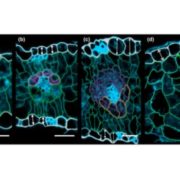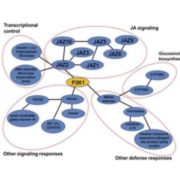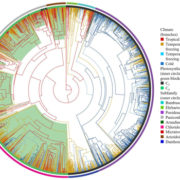
Hydrogen peroxide acts downstream of melatonin to induce lateral root formation
Blog, Plant Science Research Weekly, Research, Research BlogAnn. Botany. Melatonin was first identified in plants in 1995. Since then, it has been found to be involved in many aspects of plant response to biotic and abiotic stress. Chen et al. investigate the effect of melatonin during lateral root (LR) development in alfalfa and Arabidopsis seedlings. Exogenous…

A barley powdery mildew fungus non-autonomous retrotransposon encodes a peptide that supports penetration success on barley
Blog, Plant Science Research Weekly, Research, Research BlogBioRxiv. Barley powdery mildew is an important asmocycete disease caused by the fungus Blumeria graminis f. sp. hordei. Previous literature in this field has investigated susceptibility genes as important targets to develop resistance. A well-known example of this, is the MLO gene, a negative regulator…

How to make a tumour: cell type specific dissection of Ustilago maydis-induced tumour development in maize leaves
Blog, Plant Science Research Weekly, Research, Research BlogNew. Phytol. Ustilago maydis causes corn smut disease on maize which is characterized by plant cancerous symptoms forming tumours on all aerial parts of host. The fungus deploys organ-specific effector proteins to re-program organ primordia to enormous tumours, however the cellular dissection of these…

Extracellular ATP acts on jasmonate signaling to reinforce plant defense
Blog, Plant Science Research Weekly, Research, Research BlogPlant Physiol. Extracellular ATP induces plant defense responses but the mechanisms involved are largely unknown. The paper by Tripathi et al. shows how extracellular ATP serves as a danger signal in plant defense and its interaction with the signalling pathways of other stress hormones, e.g. jasmonate…

MicroRNAs from the parasitic plant Cuscuta campestris target host messenger RNAs
Blog, Plant Science Research Weekly, Research, Research BlogNature. Cuscuta sp. commonly known as dodder, is an obligate parasitic plant that colonizes a broad range of host plants and obtain water and nutrients by specialized feeding structure called haustorium. Literature suggests that this specialized structure is involved in bidirectional movement of viruses,…

Spatial and temporal patterns of mass bleaching of corals in the Anthropocene
Blog, Plant Science Research Weekly, Research, Research BlogScience. As our ecosystems are changing rapidly, more studies are needed to document them. One of these important events is “coral bleaching”, a phenomenon that occurs due to environmental stress and when coral hosts lose their algal symbionts or zooxanthellae (Symbiodinium spp.), showing the white…

Genome downsizing, physiological novelty, and the global dominance of flowering plants
Blog, Plant Science Research Weekly, Research, Research BlogPLOS Biol. Guard cell size is, in general, inversely related to stomatal density. It is advantageous for plants to maximize their photosynthetic capabilities by generating higher rates of gas exchange, thereby incorporating more CO2 to help drive this pathway. However, the number of cells that can occupy…

What We're Reading: January 26th
Blog, Research, Research Blog, WWR Full PostGuest Editor: Dr. Amey Redkar
Amey is a postdoc at The Sainsbury Laboratory, Norwich, UK and has been a Plantae Fellow since September 2017. He is working to understand the interaction of plants and pathogens during disease development. His current research which is funded by EMBO Long Term Fellowship…

Talking about talking about plant science with Professor Daniel Chamovitz
Plantae Webinars, Science Communication0 Comments
/
About this Webinar:
Dr. Chamovitz is a sought-after speaker and science commentator. His 2012 book What a Plant Knows has been published in 13 languages, was voted Top 10 in Amazon and is often referred to in discussions on plant senses and intelligence. He has been interviewed in newspapers…

